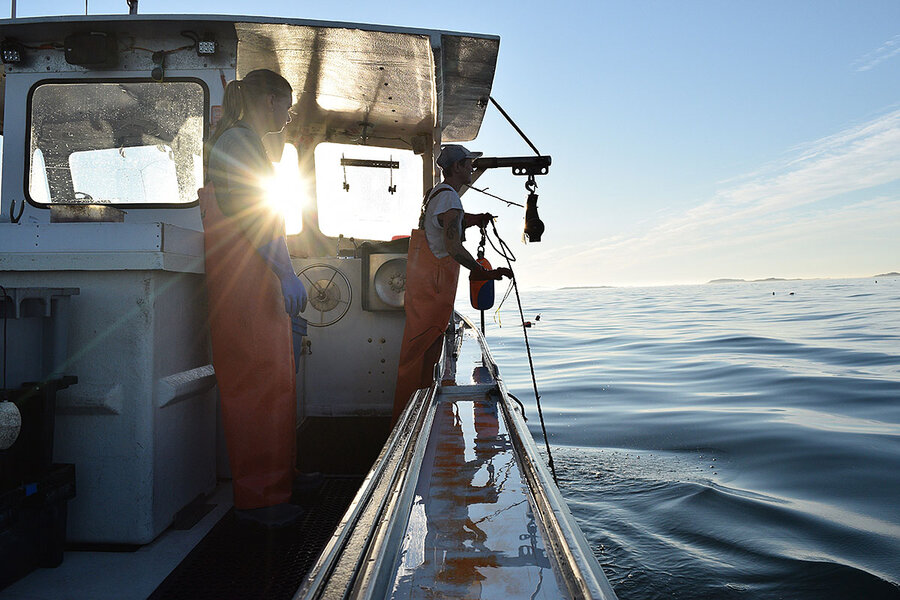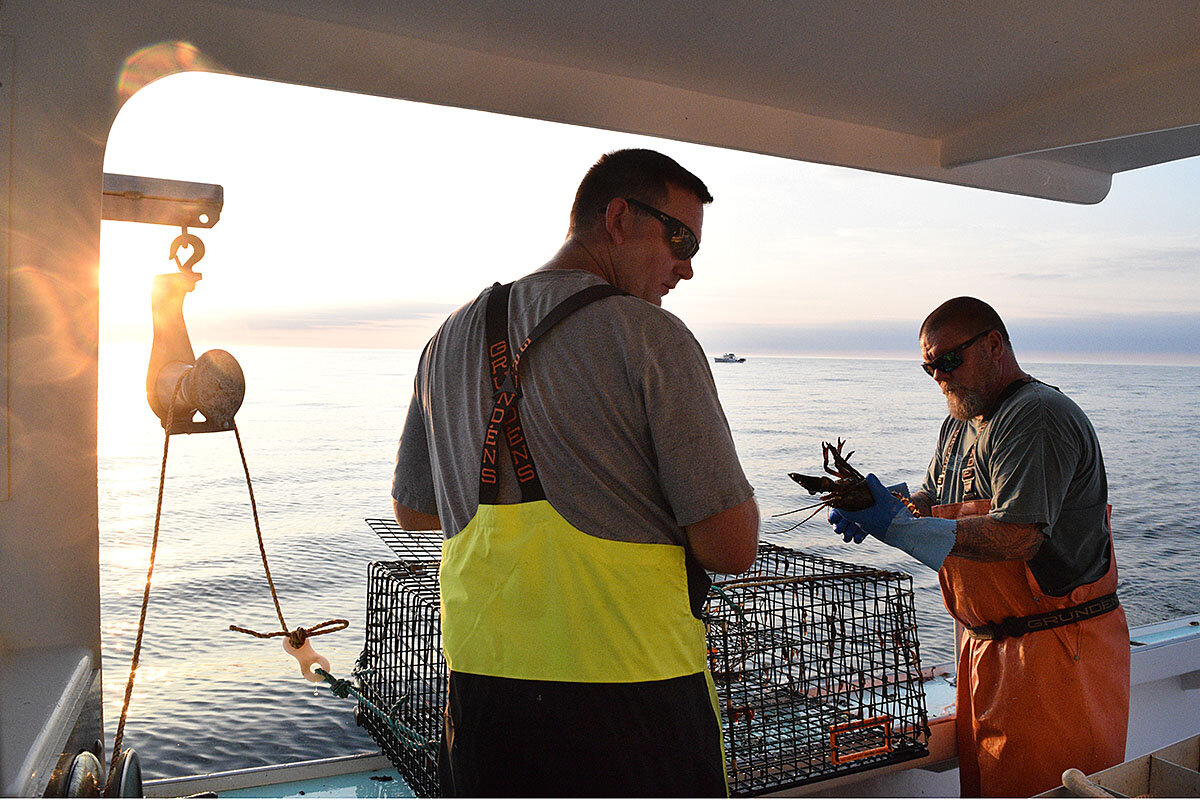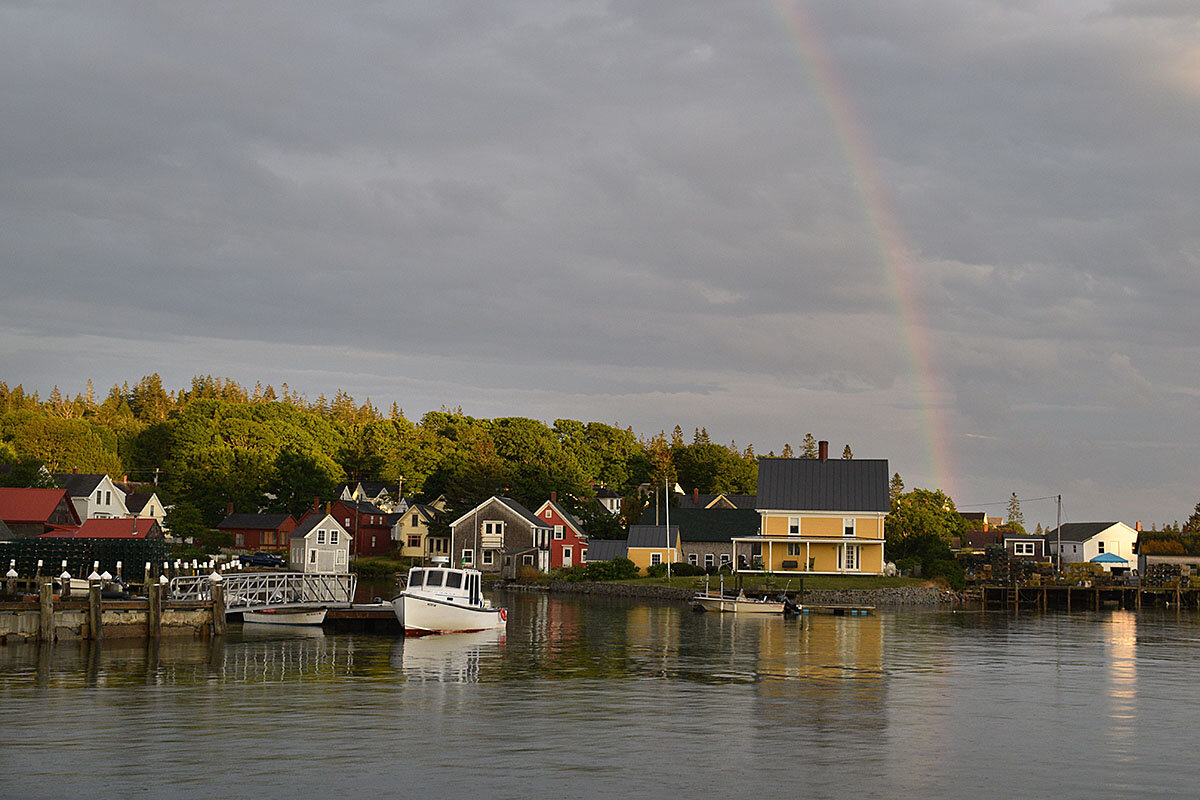For New England lobstermen, resilience in ‘a season of uncertainty’
Loading...
| Vinalhaven, Maine, and Chatham, Massachusetts
“Gimmie a Hulla” motors across the glassy harbor, backed by the silhouettes of trees and the rocky shoreline. Yvonne “Beba” Rosen is heading out to haul her lobster traps at 5:30 a.m., as she does five days a week, April through November.
This is a tough season so far for Ms. Rosen, but over her 15 years of lobstering off Vinalhaven, Maine, she’s always been a better fall fisherman, she says. This season is like no other – the lobsters are slow to appear, but more than that, the coronavirus has caused trade to plummet and tourists to stay home.
Ms. Rosen squints into the sun, now sitting just above the horizon, and half shouts over the guttural diesel engine. “Tourists come to Maine to eat lobster. That’s what they do,” she says grimly, hands on the wheel.
Why We Wrote This
Before the pandemic, New England lobstermen benefited from warming waters and high demand. Choppy waters lie ahead.
Without the regular influx of tourists, and with restaurants across the country closed entirely or open with limitations, lobstermen in Maine and Cape Cod have gotten creative to keep operating their boats, exercising the resilience for which the industry is known.
A slow spring is not unusual, although this one was difficult because “markets were really feeling the brunt of the supply chain,” says Patrice McCarron, executive director of the Maine Lobstermen’s Association.
“There’s a lot of anxiety because [lobstermen] really don’t know what the season’s going to hold,” she says. “People are also really grateful that they’re able to be out there and work.”
“A wave of abundance”
Over the last several decades, global warming has produced “a wave of abundance” of lobsters from southern New England into Atlantic Canada, says Richard Wahle, a research professor at the University of Maine and founder of the American Lobster Settlement Index, which tracks lobster populations in the region.
“We seem to be falling off the crest of that wave now,” he says, and the fishery has been slowly declining in southern New England as the waters warm too much, while seeing record-breaking numbers in the north and east of the Gulf of Maine.
In Maine, Ms. Rosen is selling her lobster for $3.35 per pound – a dollar less than last year – and she’s torn between wanting to catch more and worrying about flooding the market by catching too much. To supplement, she picked up a job with UPS in the afternoons after fishing. On the cape, some lobstermen supplement their incomes with rental properties or the occasional tuna, which can sell for hundreds of dollars.
Ms. Rosen often fishes for her own bait rather than buying it. The day before, she went fishing for pogie, catching $400 worth of bait.
From getting a lobstering license, to operating and maintaining a boat, to paying a crew, “nothing’s cheap in this business,” says Ms. Rosen, peering over the gunwale, ready to snag the next float and feed the line into the hauler.
Finding a market
On Cape Cod, Glen Sveningson has been getting about $5.30 a pound wholesale, but it’s starting to fall. “Last year was one of the best years I’ve seen,” he says.
This season is going fine, but not particularly well, he says as he speeds up the hydraulic hauler, whipping 70 feet of line into a rope locker at his feet. “It’s definitely a little bit of an off year,” he says, though he’s optimistic. “It’s just a late start. Every year’s different.”
In the spring, before it was clear how supply chains would adapt, some lobstermen began selling directly to consumers. While it’s a good way to supplement, it’s not a strategy “that’s going to take care of all of the volume that we land in Maine,” says Ms. McCarron.
Mr. Sveningson has been selling around 50 pounds of lobster directly for about $9 a pound every time he fishes, but he didn’t do it in past years. “I don’t like to do it,” he says. “It’s a pain. It’s one more thing.”
It’s not worth selling directly to consumers on Vinalhaven, where the year-round population is only 1,200. Ms. Rosen has some customers she sells directly to every summer, but never more than a dozen or so lobsters. Still, “it helps,” she says, shrugging. It’s just not worth it to drive her boat 15 miles from the island to Rockport to sell a greater quantity.
The pandemic has already produced a concerted effort to connect fishermen with consumers. Ali Farrell, who is soon publishing a book about women fishermen, started the United Fishermen Foundation just a few months ago when an effort to help her friends by posting on Facebook when they had seafood to sell turned into a page with over 6,000 followers. The foundation’s website now lists fishermen in Maine, New Hampshire, Connecticut, Florida, and Cape Cod, and they just added one in Rhode Island.
About 70% of Maine’s seafood is eaten out of state, so the Maine Lobster Marketing Collaborative, which serves as the marketing arm for fishermen and suppliers, typically focuses on chefs and restaurants. Following the pandemic, the collaborative pivoted to focus on grocery stores and online shippers. Lobster is shipped all over the world, but foreign markets are volatile, so the collaborative focuses on the U.S.
Lobstermen are “a very resourceful people and they’ve met a number of challenges in the past that they’ve adapted to,” says Marianne LaCroix, executive director of the Maine Lobster Marketing Collaborative. “I think it’s going to be a very tough year, but … I think they’ll pull through it.”
A helping hand
The Maine Coast Fishermen’s Association works with a number of fisheries coastwide to help fishermen navigate policy and support them at the federal and state level, says Monique Coombs, director of marine programs. The association began hosting webinars in the early spring and hired accountants to help fishermen receive funding and small-business loans – of which lobstermen received more than any other sector in Maine.
Since 2018, the association has been working with the mental health nonprofit NAMI Maine. “The mental health and well-being of fishermen is important all of the time, but especially so during this pandemic,” says Ms. Coombs, “as many of them have exacerbated uncertainties in their business.”
The season may be tough. But back on the bay, baiting bags and hoping for the next trap to be full, there’s nothing else Ms. Rosen can imagine doing. She spins the wheel, preparing to haul another line of traps. Until she can’t, she’ll keep hauling trap after trap, hoping for business to become more profitable again.
She shakes her head as she looks over the bow toward the horizon: “It’s a season of uncertainty.”









